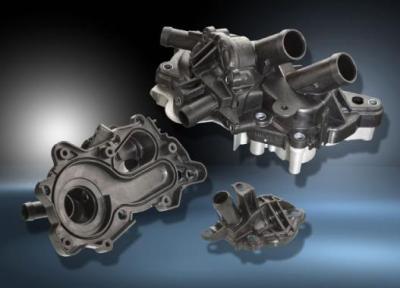VW has been using thermostat housings made from BASF’s Ultramid A3WG6 HRX from February 2012.
 The upper half of the thermostat housing for the new TSI 1.4-liter gasoline engine from VW is manufactured by the automotive supplier Veritas in Gelnhausen for the VW engine factory in Salzgitter. The part is made of the new, especially hydrolysis-resistant grade Ultramid® A3WG6 HRX from BASF and withstands not only hot water up to peak temperatures of 130 °C, but also high pressures. The smaller thermostat cover is molded from the even-stiffer Ultramid® A3WG7 HRX, since it is subject to especially high stress as a result of the threaded geometry.
The upper half of the thermostat housing for the new TSI 1.4-liter gasoline engine from VW is manufactured by the automotive supplier Veritas in Gelnhausen for the VW engine factory in Salzgitter. The part is made of the new, especially hydrolysis-resistant grade Ultramid® A3WG6 HRX from BASF and withstands not only hot water up to peak temperatures of 130 °C, but also high pressures. The smaller thermostat cover is molded from the even-stiffer Ultramid® A3WG7 HRX, since it is subject to especially high stress as a result of the threaded geometry.
The company has specifically made this new polyamide specialty for use in applications that need high strength and high hydrolysis resistance. Currently, this new material is globally available. Production is ongoing at Germany-based Veritas for use in the VW engine plant located in Salzgitter.
The new material is used to mold the cover of the coolant control module, which can potentially withstand challenging conditions that includes a high pressure at a maximum temperature of up to 130° C with minimal deformation, as this may decrease the efficiency of the module.
The housing cover that was molded using polyamide specialty provides cost and weight benefits, when compared to its previous aluminum counterparts. The finish machining process is not necessary for the molded plastic part, unlike the metal element. This molded plastic part can easily attain the preferred precision in dimensions, particularly for sealing surfaces. Integration of valve seats, holders, supports and other functions into the molded part is very simple and does not involve any special effort. The plastic’s high surface quality is significant, as it offsets abrasion through the coolant.
The CAE professionals at BASF offered the needed support to the customers during design, due to the Ultramid-molded demanding plastic components. Optimal gate positioning was performed very carefully. This enabled shifting of the unavoidable weld lines having less strength to housing areas subject to lesser loads.
Thermostat loads, the component’s long-term stiffness under the seal and the internal coolant pressures were key challenges to be tackled by Veritas. The universal simulation tool, ULTRASIM from BASF helped to examine the element’s creep behavior and optimize design.